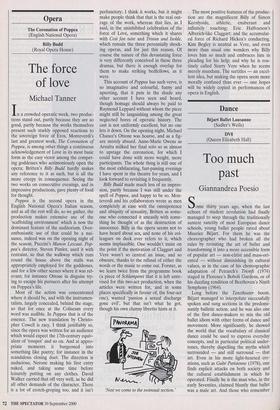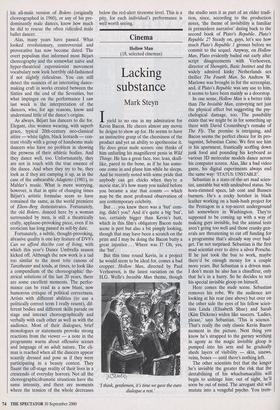Dance
DVS (Queen Elizabeth Hall)
Too much past
Giannandrea Poesio
Some thirty years ago, when the last echoes of student revolution had finally managed to seep through the traditionally austere sanctity of most European dance schools, young ballet people raved about Maurice Mart. For them he was the choreographer who had broken all the rules by revisiting the art of ballet and transforming it into a more accessible form of popular art — non-elitist and mass-ori- ented — without diminishing its cultural values, as in the case of his choreographic adaptation of Petrarch's Trionfi (1974) staged in Florence's Boboli Gardens, or of his dazzling rendition of Beethoven's Ninth Symphony (1964).
Long before the Tanztheater boom, Bejart managed to interpolate successfully spoken and sung sections in the predomi- nantly balletic action, and be was also one of the first dance-makers to mix the old ballet idiom with other forms of dance and movement. More significantly, he showed the world that the vocabulary of classical dance could be used to express everyday concepts, and in particular political under- tones, thereby dispelling the myths which surrounded — and still surround — that art. Even in his more light-hearted cre- ations, such as Grate' Parisienne (1978), one finds explicit attacks on both society and the cultural establishment in which he operated. Finally he is the man who, in the early Seventies, claimed bluntly that ballet was a male art. And those who remember his all-male version of Bolero (originally choreographed in 1960), or any of his pre- dominantly male dances, know how much he did to rescue the often ridiculed male ballet dancer.
Alas, many years have passed. What looked revolutionary, controversial and provocative has now become dated. The overt populism that informed most Bejart choreography and the somewhat naive and hyper-theatrical expressionist movement vocabulary now look horribly old-fashioned if not slightly ridiculous. You can still detect the nuances of an interesting dance- making craft in works created between the Sixties and the end of the Seventies, but what impinges on the performance I saw last week is the interpretation of the dancers, who, for age reasons, know and understand little of the dance's origins.
As always, Mart has dancers to die for. Elegant, chic women wearing, with superb grace, typical 20th-century neo-classical attire — white tights, black leotards — con- trast vividly with a group of handsome male dancers who have no problem in showing the prowess of their athletic bodies. And they dance well, too. Unfortunately, they are not in touch with the true essence of the dance. And when they try to be, they look as if they are camping it up, as in the case of the unbearable Adagietto (1981), to Mahler's music. What is more worrying, however, is that in spite of changing times Bejart's artistic formulae seem to have remained the same, as the world premiere of Elton–Berg demonstrates. Fortunately, the old Bolero, danced here by a woman surrounded by men, is still a theatrically crafty, applause-provoking piece, even if its eroticism has long passed its sell-by date.
Fortunately, a subtle, thought-provoking, abrasive quality is one key feature of DV8's Can we afford this/the cost of living, with which this year's Dance Umbrella season kicked off. Although the new work is a tad too similar to the most trite canons of Tanztheater and tends, at times, to look like a compendium of the choreographic/ the- atrical solutions of the last 20 years, there are some excellent moments. The perfor- mance can be read as a now blunt, now humorous critique of political correctness. Artists with different abilities (to use a politically correct term I really resent), dif- ferent bodies and different skills parade on stage and interact choreographically and verbally with each other as well as with the audience. Most of their dialogues, brief monologues or statements provoke strong reactions from the viewer — a note in the programme warns about offensive scenes and language of an adult nature. The cli- max is reached when all the dancers appear scantily dressed and pose as if they were participating in a beauty contest. They flaunt the off-stage reality of their lives in a crescendo of everyday horrors. Not all the choreographic/dramatic situations have the same intensity, and there are moments where the tension of the whole decreases below the red-alert tiresome level. This is a pity, for each individual's performance is well worth seeing.



























































































 Previous page
Previous page